北邮通原2006上册期末考试题及答案
- 格式:pdf
- 大小:367.14 KB
- 文档页数:8
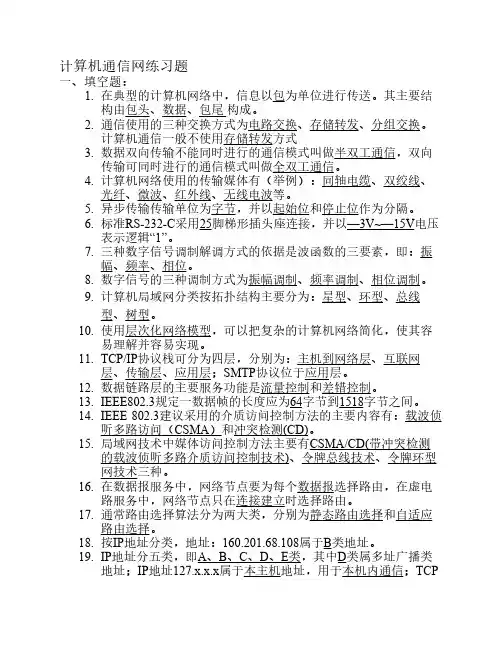
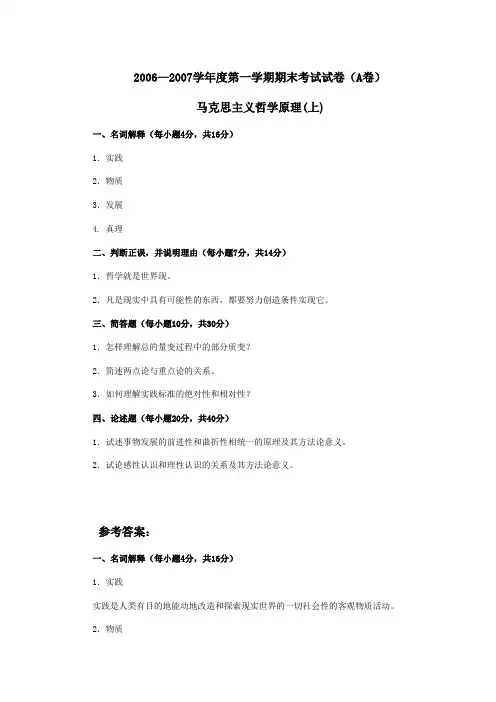
2006—2007学年度第一学期期末考试试卷(A卷)马克思主义哲学原理(上)一、名词解释(每小题4分,共16分)1.实践2.物质3.发展4. 真理二、判断正误,并说明理由(每小题7分,共14分)1.哲学就是世界现。
2.凡是现实中具有可能性的东西,都要努力创造条件实现它。
三、简答题(每小题10分,共30分)1.怎样理解总的量变过程中的部分质变?2.简述两点论与重点论的关系。
3.如何理解实践标准的绝对性和相对性?四、论述题(每小题20分,共40分)1.试述事物发展的前进性和曲折性相统一的原理及其方法论意义。
2.试论感性认识和理性认识的关系及其方法论意义。
参考答案:一、名词解释(每小题4分,共16分)1.实践实践是人类有目的地能动地改造和探索现实世界的一切社会性的客观物质活动。
2.物质物质是标志客观实在的哲学范畴,这种客观实在是人通过感觉感知的,它不依赖于我们的感觉而存在,为我们的感觉所复写、摄影、反映。
3.发展发展是前进的变化或进化,是旧事物的死亡与新事物的产生。
4. 真理真理是标志主观同客观相符合的哲学范畴,是思维对客观世界的正确反映。
二、判断正误,并说明理由(每小题7分,共14分)1.哲学就是世界现。
错误。
(2分)哲学和世界观既有联系又有区别。
哲学作为一门学科,它是关于世界观的学问,是世界观的理论化和系统化。
世界观则是人们对整个世界的总的看法或根本观点。
每个有一定生活经验的人都有世界观,但并非每个人都自觉地系统地掌握某种世界观的理论体系。
原始社会的人也有世界观,但还没有哲学。
(5分)2.凡是现实中具有可能性的东西,都要努力创造条件实现它。
错误。
(2分)在现实中具有可能性的东西存在着很复杂的情况。
一般来说,从对人的利害关系看,有好的可能性和坏的可能性,我们要努力创造条件争取实现好的可能性,尽力避免坏的可能性转化为现实。
(5分)三、简答题(每小题10分,共30分)1.怎样理解总的量变过程中的部分质变?(1)量变和质变是互相渗透的,在事物的发展过程中,由于矛盾运动的复杂性,事物的量变和质变不是以纯粹的形态出现,而总是互相交织的;总的量变过程中的部分质变,就是其中的一种情形。
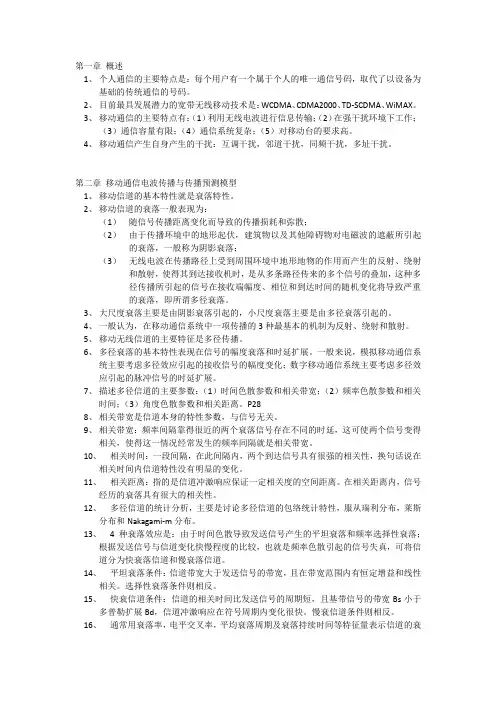
第一章概述1、个人通信的主要特点是:每个用户有一个属于个人的唯一通信号码,取代了以设备为基础的传统通信的号码。
2、目前最具发展潜力的宽带无线移动技术是:WCDMA、CDMA2000、TD-SCDMA、WiMAX。
3、移动通信的主要特点有:(1)利用无线电波进行信息传输;(2)在强干扰环境下工作;(3)通信容量有限;(4)通信系统复杂;(5)对移动台的要求高。
4、移动通信产生自身产生的干扰:互调干扰,邻道干扰,同频干扰,多址干扰。
第二章移动通信电波传播与传播预测模型1、移动信道的基本特性就是衰落特性。
2、移动信道的衰落一般表现为:(1)随信号传播距离变化而导致的传播损耗和弥散;(2)由于传播环境中的地形起伏,建筑物以及其他障碍物对电磁波的遮蔽所引起的衰落,一般称为阴影衰落;(3)无线电波在传播路径上受到周围环境中地形地物的作用而产生的反射、绕射和散射,使得其到达接收机时,是从多条路径传来的多个信号的叠加,这种多径传播所引起的信号在接收端幅度、相位和到达时间的随机变化将导致严重的衰落,即所谓多径衰落。
3、大尺度衰落主要是由阴影衰落引起的,小尺度衰落主要是由多径衰落引起的。
4、一般认为,在移动通信系统中一项传播的3种最基本的机制为反射、绕射和散射。
5、移动无线信道的主要特征是多径传播。
6、多径衰落的基本特性表现在信号的幅度衰落和时延扩展。
一般来说,模拟移动通信系统主要考虑多径效应引起的接收信号的幅度变化;数字移动通信系统主要考虑多径效应引起的脉冲信号的时延扩展。
7、描述多径信道的主要参数:(1)时间色散参数和相关带宽;(2)频率色散参数和相关时间;(3)角度色散参数和相关距离。
P288、相关带宽是信道本身的特性参数,与信号无关。
9、相关带宽:频率间隔靠得很近的两个衰落信号存在不同的时延,这可使两个信号变得相关,使得这一情况经常发生的频率间隔就是相关带宽。
10、相关时间:一段间隔,在此间隔内,两个到达信号具有很强的相关性,换句话说在相关时间内信道特性没有明显的变化。
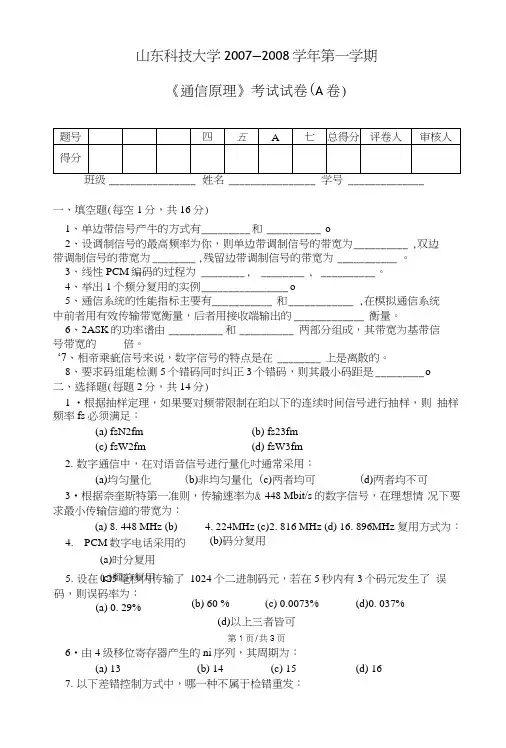
山东科技大学2007—2008学年第一学期《通信原理》考试试卷(A 卷)班级 ________________ 姓名 ________________ 学号 ______________一、填空题(每空1分,共16分)1、 单边带信号产牛的方式有 _________ 和 __________ o2、 设调制信号的最高频率为你,则单边带调制信号的带宽为 __________ ,双边 带调制信号的带宽为 ________ ,残留边带调制信号的带宽为 ___________ 。
3、 线性PCM 编码的过程为 ________ , ________ , __________ 。
4、 举出1个频分复用的实例 ________________ o5、 通信系统的性能指标主要有 ___________ 和 ____________ ,在模拟通信系统 中前者用有效传输带宽衡量,后者用接收端输出的 _____________ 衡量。
6、 2ASK 的功率谱由 __________ 和 __________ 两部分组成,其带宽为基带信 号带宽的 倍。
‘7、相帝乘疵信号来说,数字信号的特点是在 ________ 上是离散的。
8、要求码组能检测5个错码同时纠正3个错码,则其最小码距是 _________ o 二、选择题(每题2分,共14分)1 •根据抽样定理,如果要对频带限制在珀以下的连续时间信号进行抽样,则 抽样频率fs 必须满足:(a) fsN2fm (b) fs23fm (c) fsW2fm (d) fsW3fm 2. 数字通信中,在对语音信号进行量化吋通常采用: (a)均匀量化 (b)非均匀量化 (c)两者均可 (d)两者均不可3•根据奈奎斯特第一准则,传输速率为& 448 Mbit/s 的数字信号,在理想情 况下要求最小传输信道的带宽为:4. 224MHz (c)2. 816 MHz (d) 16. 896MHz 复用方式为: (b)码分复用 (d)以上三者皆可第1页/共3页6•由4级移位寄存器产生的ni 序列,其周期为:(a) 13 (b) 14 (c) 15 (d) 167. 以下差错控制方式中,哪一种不属于检错重发:(a) 8. 448 MHz (b)4. PCM 数字电话采用的(a)时分复用(c)频分复用 5. 设在125毫秒内传输了 1024个二进制码元,若在5秒内有3个码元发生了 误码,则误码率为:(a) 0. 29%(b) 60 % (c) 0.0073% (d)0. 037%(a )停发等候重发 (b )返回重发 (c )选择重发(d )前向纠错三、数字通信系统模型框图如下,试填写空缺部分(10分)四、已知线性调制信号表示式如下:(每题5分,共10分) 1、cosQzcos w (.t2^ (1 + 0.5sinQr )cos w c t式中,叭=4Q 。
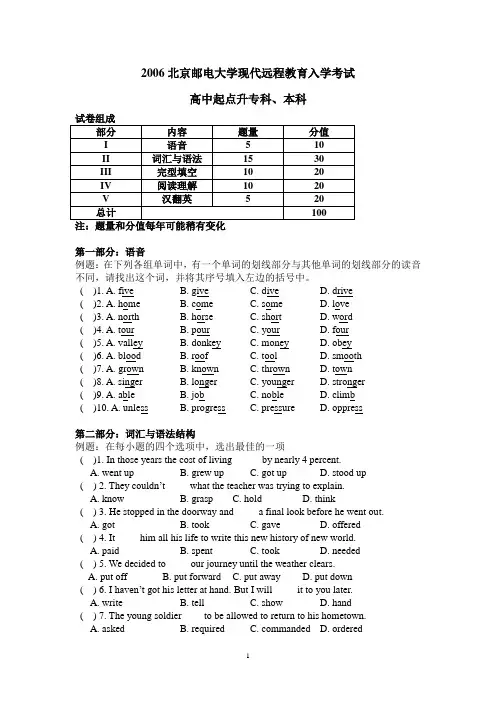
2006北京邮电大学现代远程教育入学考试高中起点升专科、本科第一部分:语音例题:在下列各组单词中,有一个单词的划线部分与其他单词的划线部分的读音不同,请找出这个词,并将其序号填入左边的括号中。
( )1. A. five B. give C. dive D. drive( )2. A. home B. come C. some D. love( )3. A. north B. horse C. short D. word( )4. A. tour B. pour C. your D. four( )5. A. valley B. donkey C. money D. obey( )6. A. blood B. roof C. tool D. smooth( )7. A. grown B. known C. thrown D. town( )8. A. singer B. longer C. younger D. stronger( )9. A. able B. job C. noble D. climb( )10. A. unless B. progress C. pressure D. oppress第二部分:词汇与语法结构例题:在每小题的四个选项中,选出最佳的一项( )1. In those years the cost of living _____ by nearly 4 percent.A. went upB. grew upC. got upD. stood up( ) 2. They couldn’t ____ what the teacher was trying to explain.A. knowB. graspC. holdD. think( ) 3. He stopped in the doorway and ____ a final look before he went out.A. gotB. tookC. gaveD. offered( ) 4. It ____ him all his life to write this new history of new world.A. paidB. spentC. tookD. needed( ) 5. We decided to ____ our journey until the weather clears.A. put offB. put forwardC. put awayD. put down( ) 6. I haven’t got his letter at hand. But I will ____ it to you later.A. writeB. tellC. showD. hand( ) 7. The young soldier____ to be allowed to return to his hometown.A. askedB. requiredC. commandedD. ordered( ) 8. He was ____ to have had the chance of studying music here.A. youngB. hopefulC. eagerD. lucky( ) 9. I have failed in the entrance examination, ____ I shall try again.A. andB. thoughC. althoughD. but( )10. What was there to be ____? Nothing at all. It is quite bright outside now. A. afraid of B. angry with C. ready for D. surprised at( )11. They have been walking all the day on ____, so their ____ are hurting.A. feet; footB. feet; feetC. foot; footD. foot; feet( )12. What ____ exciting piece of news it is! ___ news will inspire everybody. A. a; A B. the; The C. an; The D. the; An( )13. We were thirsty then and wanted some coffee, but there was ___ left there.A. noB. noneC. no oneD. not one( )14. He has two daughters, but___ was willing to nurse the sick old man.A. eitherB. neitherC. bothD. all( )15. We had expected to see___ foreign visitors there, but didn’t see____.A. any; someB. any; anyC. some; someD. some; any( )16. In the city there are about___ people who have got___ of pounds in the bank.A. hundreds; thousandsB. a hundred; a thousandC. a hundred; thousandsD. hundreds; a thousand( )17. He sings ____ now than he did before as his throat has started to ache___. A. badly; badly B. worse; worseC. badly; worseD. worse; badly( )18. “Listen, Mary is singing in the room.”“That___ Mary. She is in hospital.”A. may not B. shouldn’t C. wouldn’t D. can’t( )19. He often ___ trips to Europe in his childhood, but seldom___ there now. A. made; goes B. makes; went C. made; went D. makes; goes ( )20. He ___ the book by last summer, but ___ it a few times since then.A. hadn’t read; has readB. hasn’t read; had readC. hadn’t read; readD. didn’t read; read( )21. The judge ordered that the prisoner____ free for he was not guilty at all.A. is setB. was setC. will be setD. be set( )22. The tools in the workshop are not allowed____.A. to take outB. to be taken outC. being taken outD. taking out ( )23. He enjoys ___ his sister for walks along the country road in the evenings. A. to take B. taking C. take D. took( )24. It is no use ___ more people there. It is right of you ___ the people there. A. to send; to keep B. sending; keepingC. sending; to keepD. to send; keeping( )25. The teacher praised the naughty student for ___ his English in a very short timeA. having improvedB. has improvedC. improvedD. improving( )26. ___ his best friend, I ought to try my best___ him out of the trouble.A. I’m; to helpB. Being; to helpC. Being; helpD. I’m; help( )27. The house ___ across the river will be the teachers’ dormitory whencompleted.A. builtB. being builtC. buildingD. having built( ) 28. People ___ to the town hall were mostly foreign professors___ in the city.A. inviting; workingB. invited; workedC. invited; workingD. inviting; worked( )29. When ___ the child. She shouted. And the child, when___, said nothing.A. beaten; beatenB. beating; beatingC. beating; beatenD. beaten; beating( )30. His uncle often takes a walk after dinner, and ____.A. his father does soB. so does his fatherC. does so his fatherD. his father so does( )31. “He can’t be in the library now, __ he?”“Yes, I think, he ___ be there.”A. can; mustB. must; canC. can’t; mustn’tD. mustn’t can’t( )32. I haven’t decided yet____. Do you have any advice for me in this respect?A. which will I buyB. which I will buyC. how will I buyD. how I will buy( )33. I still remember the place ___ our class did some field work ten years ago.A. thereB. whichC. whereD. when( )34. I’ve always longed for the time___ I will be able to be independent.A. thatB. whichC. whenD. while( )35. Although he is considered a great writer, ___ his works are not widely read.A. butB. howeverC. andD. /( )36. I feel it an honor____ to speak here.A. to askB. to be askedC. askingD. having asked ( )37. ___ white, the kitchen looks much better than before.A. PaintsB. paintedC. paintingD. To paint ( )38. ____ to take medicine as the doctor told yesterday.A. Not forgetB. Not to forgetC. Don’t forgetD. Forget not ( )39. Next time he will visit the airbase____ he worked 25 years agoA. whenB. asC. whereD. which( )40. Hard as he worked,____ He couldn’t make enough money to support his family.A. andB. butC. thereforeD. /第三部分:完型填空例题:(一)Sometimes I feel that being the mother of three small children is like operating a large circus (马戏团). 1 afternoon last week, my three sons were playing peacefully in the back yard (院子), 2 the ball from one to 3 . I jumped at the 4 to talk to one of my friends 5 the phone, but before I 6 to the phone, I could tell the boys had begun to quarrel with each other about something. I rushed out to 7 peace, but before I got there Charles had 8 a rock at Mark, and hit him 9 the eye. By the time I got to the back yard, they had begun to 10 about this. Even David, the oldest boy, who won’t usually fight with anybody about 11 , was involved (卷入). First, I 12 them stop fighting, and then I examined Mark’s eye. I decided that it wasn’t going to 13 into a black eye, but I felt that they should 14 at least a little for 15 they had done. “I’m going to 16 to y our father about this when he comes home tonight,” I said. “He and I will think of how to punish you.” Things were 17 quiet after that for about half an hour, and then Charles 18 a glass in the kitchen, and at almost the same 19 , Mark fell out of the apple tree. I 20 I will be able to laugh at all these things some day. In the meantime (其间) ,I just pray (祈祷) to heaven for patience.l. A. Certain B. A C. Some D. one2. A. catching B. throwing C. beating D. playing3. A. another B. an other C. other D. the other4. A. time B. minute C. moment D. chance5. A. through B. in C. on D. by6. A. went B. came C. reached D. got7. A. keep B. make C. get D. have8. A. thrown B. hit C. beaten D. stricken9. A. in B. into C. at D. on10. A. quarrel B. talk C. worry D. fight11. A. nothing B. something C. anything D. any thing12. A. told B. ordered C. let D. made13. A. become B. grow C. turn D. develop14. A. suffer B. punish C. criticize D. beat15. A. fight B. that C. things D. what16. A. tell B. speak C. report D. inform17. A. pretty B. much C. very much D. a lot18. A. bet B. hit C. broke D. struck19. A. moment B. second C. minute D. hour20. A. sure B. certain C. believe D. doubt(二)The practice of chewing(咀嚼)gum(口香糖)has become with us for more than a century. Millions of people all __1__the world chew billions of pieces (or “sticks” ) of gum every year.Chewing gum ___2_ popular in the United States mainly because of the ___3_ of one man,William Wrigley, who for many years__4___ head of the Wrigley Company. _5__, Thomas Admas first began to experiment with chewing gum___6_ about the year 1870. it was he who first ____7_ gum softer and pleasant to chew. But it was __8__ until Wrigley entered the business in about 1890 that people everywhere began to learn about chewing gum and ___9__ it widely.Wrigley liked to do things ___10_ abig way. In his __11_year, he borrowed money and ___12 more than a million dollars on advertising (登广告). __13_ years, there was a large Wrigley’s advertisement in every streetcar in the United States. People complained (抱怨) that they could not go __14__ without seeing Wrigley’s name. Wrigley even __15__, free of charge, pieces of gum to every person in the telephone book of every city and town in the United States. Finally, he began to advertise that it was __16_ for the health to chew gum, ___17 it calmed the nerves(神经), and that it helped to keep the teeth clean.He employed (雇佣) young women who would go from city to city in ___18 of four or five, stand on street corners, and give free samples (样品) of chewing gum to ___19_ person who passed by. In this way, each woman gave away about five thousand sticks of Wrigley’s gum every day. As a __20__f this continuous advertising, people in the United States naturally began to use more and more chewing gum.1. A. in B. on C. over D. through2. A. became B. grew C. turned D. got3. A. service B. job C. work D. invention4. A. worked B. was C. stayed D. became5. A. First B. Earlier C. Before D. Later6. A. for B. on C. in D. during7. A. invented B. caused C. let D. made8. A. just B. only C. not D. no9. A. eat B. drink C. produce D. use10. A. by B. through C. in D. with11. A. first B. early C. last D. beginning12. A. paid B. spent C. cost D. took13. A. During B. Through C. In D. For14. A. somewhere B. anywhere C. everywhere D. nowhere15. A. gave B. sold C. left D. sent16. A. kind B. wise C. good D. well17. A. and B. as C. so D.that18. A. lines B. teams C. groups D. crowds19. A. all B. each C. every D. some20. A. results B. reason C. cause D. victory第四部分:阅读理解例题:(一)One day in 1848 Mr. Sutter made a remarkable discovery in the American River in California by his house. He noticed some bright yellow pieces in the water and bent down to pick them up. This was the beginning of the Californian Gold Rush.Sutter realized the importance of the discovery. He sent a man to San Francisco to see the governor.The people of San Francisco did not believe him at first. But a reporter of a weekly newspaper there went to Sutter’s house to make a report. When he came back he ran through the streets of the town shouting, “Gold! Gold!”Within a month almost the entire population had gone to look for the precious(贵重的)metal. Soldiers deserted the army, sailors left their ships and men gave up their jobs so as not to miss the chance of becoming rich.The news spread across America to Europe and thousands of people joined in the search. Some sailed round Cape Horn to reach California. Some chose the overland route across America and trains were formed for travelers to make the journey. Even then there were some who were prepared to cross the terrible desert of Death Valley in order to reach the gold a few days before the others.The Gold Rush proved a disaster for Sutter himself. For years he tried to stop the people from digging his land. They did a great deal of damage (损害)and killed one of his sons, and at the end of his life he was a poor man who continually stopped people in the street to tell them that gold is the devil(恶魔).1.Which of the following isn’t true?A.The Gold Rush began in the 1940s.B.The Gold Rush was started by Mr. Sutter.C.Mr. Sutter discovered gold in California.D.Mr. Sutter first found gold in a river.2.When Mr. Sutter sent a man to San Francisco, _______.A.the governor didn’t believe himB.nobody believed his storyC. a reporter believed him at onceD. a reporter shouted to people, “Gold! Gold!”3.When the news of gold spread out,_______.A.soldiers deserted the army and went homeB.sailors left their ships and took a holidayC.men gave up their jobs to find new onesD.nearly all the Americans went to California4.How did all the people from Europe get to California?_____.A.They sailed across the Atlantic Ocean or the Pacific OceanB.They went there all the way by landC.They traveled all the way by trainD.They crossed the desert of Death Valley(二)While travelling in a foreign country, Mr. Jackson Frank was in need of money. He wrote to his brother at home, “Send me $500 by telegram to the Fisher Bank.”After a week he began visiting the bank. He showed his passport. “Nothing has come for you”, he was told. This went on for two weeks and Mr. Frank got very worried.In the fourth week Mr. Frank was sent to prison for failing to pay his hotel bill. He had tostay there for six weeks.When he came out, he went immediately to the Fisher Bank. There was a new clerk there. “Have you received $500 for me? My name is Jackson Frank.” he asked.The clerk checked his books. “Oh, yes. It came two months ago.” He said and showed Mr. Frank the order.“But my name is Jackson Frank, not Frank Jackson.”“That’s all right. It was in our books under the letter J.” The clerk laughed.“A human mistake. We’re all human beings. And so we all make mistakes.”Mr. Frank was silent. Then he said, “A human mistake is what you call it? I think some humans need kicking.”1. From the beginning of the story we learn that Mr. Frank ________.A.loved to travelB.had a rich brotherC.did not have enough money with himD.had not been to that place before2. About how many weeks did it usually take for a letter to got to Frank’s hometown from wherehe was?A. One.B. Two.C. Six.D. Eight.3. Mr. Frank was put in prison because he________.A. kept asking the bank for moneyB. did not pay the hotel in timeC. kicked some people in his angerD. did not have his passport with him4. Why did it take so long for Mr. Frank to get the money?A.It was sent from a far away place.B.The order was placed under the wrong letter.C.The bank clerk was new and inexperienced.D.It took his brother some time to send it.5. At the end of the story Mr. Frank ______.A. was surprisedB. beat the bank clerkC. was angryD. joked about the mistake(三)We want our kids (小孩) to use the Internet, and yet we worry. But we can find ways to direct our children away from what’s wrong, towards what’s best.The most effective (有效地) way to monitor (监控) a kids’ online activity is to monitor it. That is, to stand beside the computer from time to time when your child is at it.Carleton Kendrick suggests that accompanying (陪伴) your child to a website (网站) he often visits is no different from “checking out a playground where your kids go, to see that it’s safe.In any e-mail program, a look at the senders’ addresses can give you a good idea of your kids’ correspondents (通信者).America Online allows parents to limit incoming e-mails to a finite (限定的) list ofcorre spondents. Some parents also type their kids’ names into a search engine to discover what they’re saying on websites or message boards.Understand that as kids get older and demand more privacy (私密), some basic know-how comes into play. America Online has been particularly effective in helping parents give their children an online experience, a “kids-only’ AOL account (帐户) prevents young users from all but full time-monitored chat (聊天) rooms. Katherine Borsecnik, president at AOL, notes, however, that “if I have a child who’s doing a report on breast (乳房) cancer (癌), I might want to turn off the filters (过滤器)”since kids-only access (路径) would block websites with even straight medical information about breast.Many parents don’t know that a simple click (点击) on the “history”tab (键) will produce a list of links to every website the computer has visited recently. Bonnie Fell opens all the files that have been downloaded (下载) by her two sons at least once a month—”whether the boys are there or not. Although they know it.” As Jim Lynch, who manages message boards for the Boston-based FamilyEducation. com, says, “Parents are the ultimate (最后的) filter.”1. To stand beside the computer from time to time when your child is at it is .A. the most effective way to monitor a kid’s online activityB. the useful way to direct it away f rom what’s wrong and towards what’s bestC. the good way to protect it on the netD. checking out a playground where your kids go, to see that it’s safe.2. To protect their children on the net, parents can .a. accompany their children to the website they often visitb. look at the senders’ addressesc. limit incoming e-mails to a finite list of correspondentsd. type their kids’ names into a search engine to discover somethingA. abB. acC. abdD. abcd3. America Online .A. prevents young users from all but full time-monitored chat roomsB. blocks websites with even straight medical informationC. produces a list of links to every website the computer has visited recentlyD. turn off the filters4. Which of the following is right?A. Katherine Borsecnik says parents are the ultimate filter.B. Carleton Kendrick says accompanying a child to a website is the same as checking out aplaygroundC. Jim Lynch says she might want to turn off the filtersD. Bonnie Fell says she opens all the files of her two sons whether they are there or not(八)A young woman rode with her new husband in a wagon (四轮马车). They came to a log cabin (小棚屋). The man shouted and a little boy came running out of the cabin. Sarah, the young woman, got down from the wagon, opened wide her arms and held the boy close.“Hello, Abe Lincoln,” she said. “I think we’ll be good friends.”The new mother with the smiling face went to work at once. She washed Abe and his sisterand tidied (整理) their hair. And that night she threw away the boy’s mattress (床垫) of leaves and gave him a soft mattress and enough blankets to keep him warm at night.Sarah wove cloth and made new shirts for Abe. She made him new deerskin trousers and even deerskin shoes.Maybe, if she had n’t come to the cabin, he wouldn’t have lived to be a man. When Abe’s father told him not to go to school any more and help on the farm, Sarah took Abe’s part against his father. Abe would rather read than eat, and when his father told him to stop, Sarah s aid, “Let the boy read.”In 1830 the day came when Abe would leave home to work in New Salem. For the last time she had taken Abe’s part against his father. For the last time she had kept the cabin quiet so that Abe could read.More than twenty years later, when Abe, who had then become famous, was going to make a speech in a nearby town, Sarah went there just to watch him. In the crowd she tried to make herself small, but he saw her and, in front of everybody, got out of his carriage and went over and put his arms around her and kissed her. Yes, that was her Abe.“He loved me truly,” she said later.1. Which of the following is not true?A. The young woman in the wagon was Abe’s new mother.B. The man in the wagon was Abe’s new father.C. The little boy was the young woman’s new son.D. The little boy running out of the cabin was Abe.2. What did Sarah do as soon as she got to the new home?A. She washed the children and tidied their hairB. She made a comfortable bed for the boyC. She made new shirts for the boyD. both A and B, but not C3. If Sarah hadn’t come to the cabin,A. Abe’s father wouldn’t have told him not to go to schoolB. Abe wouldn’t have helped his father on the farmC. Abe wouldn’t have had so much time to readD. Abe’s father wouldn’t hav e told him to stop reading4. Sarah said Abe loved her truly becauseA. Abe saw her in the crowd though she tried to make herself smallB. Abe didn’t forget her 20 years laterC. Abe kissed her in front of everybodyD. Both A,B and C第五部分:汉翻英1.他很激动,因为半小时后就要前往北京了。
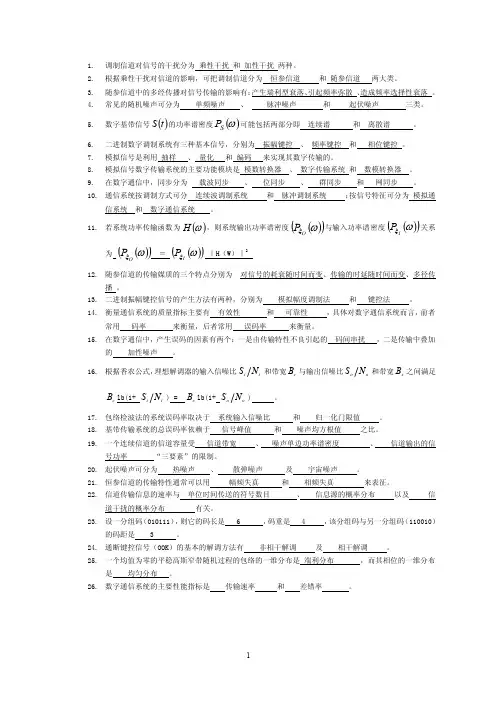
1. 调制信道对信号的干扰分为 乘性干扰 和 加性干扰 两种。
2. 根据乘性干扰对信道的影响,可把调制信道分为 恒参信道 和 随参信道 两大类。
3. 随参信道中的多经传播对信号传输的影响有:产生瑞利型衰落、引起频率弥散 、造成频率选择性衰落 。
4. 常见的随机噪声可分为 单频噪声 、 脉冲噪声 和 起伏噪声 三类。
5. 数字基带信号()t S的功率谱密度()ωS P 可能包括两部分即 连续谱 和 离散谱 。
6. 二进制数字调制系统有三种基本信号,分别为 振幅键控 、 频率键控 和 相位键控 。
7. 模拟信号是利用 抽样 、 量化 和 编码 来实现其数字传输的。
8. 模拟信号数字传输系统的主要功能模块是 模数转换器 、 数字传输系统 和 数模转换器 。
9.在数字通信中,同步分为 载波同步 、 位同步 、 群同步 和 网同步 。
10. 通信系统按调制方式可分 连续波调制系统 和 脉冲调制系统 ;按信号特征可分为 模拟通信系统 和 数字通信系统 。
11. 若系统功率传输函数为()ωH ,则系统输出功率谱密度()()ωξO P 与输入功率谱密度()()ωξI P关系为()()ωξOP = ()()ωξIP |H (W )|212. 随参信道的传输媒质的三个特点分别为 对信号的耗衰随时间而变、传输的时延随时间而变、多径传播 。
13. 二进制振幅键控信号的产生方法有两种,分别为 模拟幅度调制法 和 键控法 。
14. 衡量通信系统的质量指标主要有 有效性 和 可靠性 ,具体对数字通信系统而言,前者常用 码率 来衡量,后者常用 误码率 来衡量。
15. 在数字通信中,产生误码的因素有两个:一是由传输特性不良引起的 码间串扰 ,二是传输中叠加的 加性噪声 。
16. 根据香农公式,理想解调器的输入信噪比i i N S 和带宽c B 与输出信噪比o o N S 和带宽s B 之间满足c B lb(1+ i i N S ) = s B lb(1+ o o N S ) 。
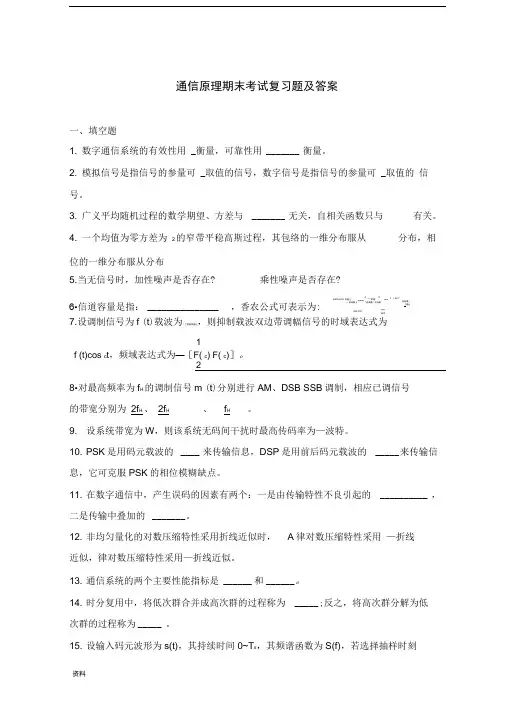
通信原理期末考试复习题及答案一、填空题1. 数字通信系统的有效性用 _衡量,可靠性用 _______ 衡量。
2. 模拟信号是指信号的参量可 _取值的信号,数字信号是指信号的参量可 _取值的 信号。
3. 广义平均随机过程的数学期望、方差与 _______ 无关,自相关函数只与 有关。
4. 一个均值为零方差为 2的窄带平稳高斯过程,其包络的一维分布服从 分布,相位的一维分布服从分布7.设调制信号为f (t )载波为「]乘器雪输岀,则抑制载波双边带调幅信号的时域表达式为1f (t)cos c t ,频域表达式为—[F( c ) F( c )]。
28•对最高频率为f H 的调制信号m (t )分别进行AM 、DSB SSB 调制,相应已调信号 的带宽分别为 2f H 、 2f H、 f H。
9. 设系统带宽为W ,则该系统无码间干扰时最高传码率为—波特。
10. PSK 是用码元载波的 ____ 来传输信息,DSP 是用前后码元载波的 _____ 来传输信 息,它可克服PSK 的相位模糊缺点。
11. 在数字通信中,产生误码的因素有两个:一是由传输特性不良引起的 __________ , 二是传输中叠加的 _______ 。
12. 非均匀量化的对数压缩特性采用折线近似时, A 律对数压缩特性采用 —折线 近似,律对数压缩特性采用—折线近似。
13. 通信系统的两个主要性能指标是 ______ 和 ______。
14. 时分复用中,将低次群合并成高次群的过程称为 _____ ;反之,将高次群分解为低 次群的过程称为 _____ 。
15. 设输入码元波形为s(t),其持续时间0~T s ,其频谱函数为S(f),若选择抽样时刻5.当无信号时,加性噪声是否存在?乘性噪声是否存在?6•信道容量是指: _______________ ,香农公式可表示为:e 2DPsK t)J 带通][—i 滤波器p 相乘器-c ______ d低通 “滤波器* 判决器抽样cos d b定时 脉冲1 ]码可f变换器」[输岀为t o = T s,则匹配滤波器的冲激响应可写为k sT s t ,相应传输函数为16. 为检测e个错码,要求最小码距d。
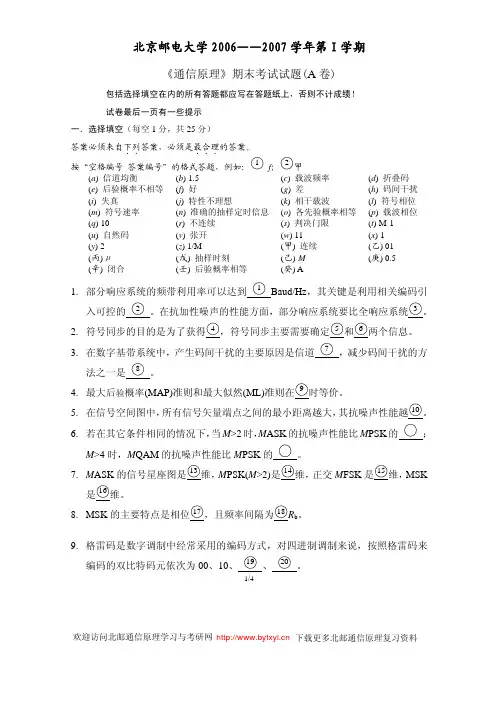
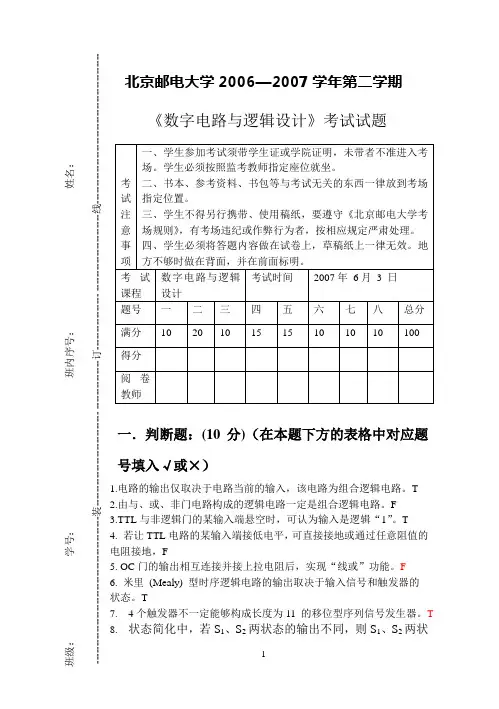
北京邮电大学2006—2007学年第二学期《数字电路与逻辑设计》考试试题一.判断题:(10分)(在本题下方的表格中对应题号填入√或×)电路的输出仅取决于电路当前的输入,该电路为组合逻辑电路。
T 由与、或、非门电路构成的逻辑电路一定是组合逻辑电路。
F 与非逻辑门的某输入端悬空时,可认为输入是逻辑“1”。
T 若让TTL 电路的某输入端接低电平,可直接接地或通过任意阻值的F门的输出相互连接并接上拉电阻后,实现“线或”功能。
F 米里 (Mealy) 型时序逻辑电路的输出取决于输入信号和触发器的 T4个触发器不一定能够构成长度为11 的移位型序列信号发生器。
T 状态简化中,若S 1、S 2两状态的输出不同,则S 1、S 2两状态肯定不等价。
T9. 实现模值为11的计数器至少需要4个触发器。
T10. TTL 门输出最大拉电流能力是指输出低电平时流入输出端的最大允许电流。
F二.选择填空题(20分,每空2分)(将正确答案填入本题下方的表格中,可能为多选题。
)1.若输入AB 均为1时,输出F =0,否则输出F =1,输入和输出之间的逻辑关系为:( C )。
(A )异或 (B) 同或 (C) 与非 (D) 或非 2.在图2-1的TTL 门电路中,输出为高电平的有( )(A ). (B ). (C ).(D )图2-13. JK 触发器在时钟脉冲的作用下,如果要使n n Q Q =+1,则输入信号JK 应为 A 。
A ,1==K JB , nn Q K Q J ==, C , nn Q K Q J ==,D ,1,==K Q J n4.函数D)D)(B D)(C A )(C B (A F +++++=的最简或与式为:( )(A)D)D)(C A )(C B (A F ++++= (B)D)A )(C B (A F +++=(C)CD D A C AB F ++= (D)B CD D AC C AB F ++=5.已知某TTL 门电路的输出端最大灌电流负载能力为4mA ,最大拉电流负载能力为2mA 。

1 8 北京邮电大学 2006-2007学 年第一学期期末试卷附答案考试科目:通信原理(A 卷)请考生注意:所有答案一律写在答题纸上,否则不计成绩。
试卷最后有公式及其他计算提示一.选择填空(每空 1 分,共 16 分)从下面所列答案中选择出最合理的答案。
在.答.题.纸.上.写上空格编号以及你所选择的答案,每空格编号只能对应一个答案。
(a )自信息 (b )窄带 (c )宽带 (d )无码间干扰 (e )信息熵 (f )码间干扰 (g )频带利用率 (h )信源的冗余度 (i )信道容量 (j )多径 (k )不能 (l )增量调制 (m )大于 (n )线性 (o )能 (p )E b /N 0 (q )从频域解除相关性 (r )等于 (s )循环 (t )误码 (u )非线性 (v )不同 (w )互信息 (x )小于(y )从时域上解除相关性 (z )相同1. 在宽带无线数字通信系统中,有两个因素对系统的误码性能有重要影响,一是和发送功率相关的 1 ,另一是和信道的频率选择性衰落相 关的 2 。
将 增大 3 减小 2 。
2. 在加性白高斯噪声信道条件下,若给定信息速率、平均发送功率及噪声功率谱密度N 0值,当进制数M 增加时,对于MFSK 可使 4 性能得到改善,对于MPSK 可使 5 性能得到改善。
3. 在信源编码中,是信源编码和数据压缩的理论基础。
4. 在信源编码中,预测编码是 7 ,离散余弦变换编码是 。
5. 若信源的信息速率 9 信道容量,则存在一种编码方式,可保证通过616 b6. 循环码具有 11 性及 12 性。
7. 信道容量是指该信道的输入与输出的最大可能值。
8. 扩频通信能够有效抑制外系统引起的14 干扰和信道引起的 15 干扰,但它在抑制加性白高斯噪声方面的能力和非扩频系统是 的。
二.(12 分)已知下图所示的系统是在加性白高斯噪声干扰条件下,对某个脉冲 g (t ) 匹配的匹配滤波器。

----------------------- Page 1-----------------------北京邮电大学2006——2007 学年第一学期《信息论》期末考试试题(A 卷)标准答案姓名班级学号分数、判断题(正确打√,错误打×)(共10分,每小题1分)1)异前置码是即时码;(√)2)最大似然准则等价于最小汉明距离准则;(×)3)离散信源记忆的长度越大,信源的符号熵越小;(√)4)一维高斯信源的熵只与其均值和方差有关;(×)5)为达到并联加性高斯噪声信道容量,在信道输入总功率给定条件下应给噪声方差大的子信道分配更多的功率;(×)6)只要信息传输速率小于信道容量,总可以找到一种编码方式使得当编码序列足够长时传输差错率任意小;(√)7)离散无记忆信源的N 次扩展源的熵是原信源熵的N 倍;(√)8)仙农的AWGN 信道容量公式是在信道输入的平均功率和幅度受限条件下推导出来的;(×)s x ,x ,L,x s ,s L,s9)当马氏源的初始状态和输出给定后,那么状态 1 2, n+1 就能0 0 1 n唯一确定;(√)10)当平均失真大于其上限 D 时,率失真函数R (D)= 0 。
(√)max二、填空题(共20分,每空2分)1) 设信源的熵为0.8 比特/符号,对信源序列进行单符号编码,码序列为0、1二元序列,如果编码效率为100%,那么每信源符号平均码长为0.8 ,码序列中“0”符号出现的概率为 1/2 ,信息传输速率为 1 比特/码符号。
2) 一阶平稳马氏源的符号转移概率为p X 2 |X 1 (0 | 0) = 0.2 ,p X 2 |X 1 (1| 1) = 0.6 ,那么符号的平稳分布为p X (0) = 1/3,p X (1) = 2/3 ;信源的符号熵为 0.8879 比特/符号。
3)一维连续随机变量X 在[a,b]区间内均匀分布时,其信源熵为 log2 (b-a) 。
第1章1.数字信号和模拟信号的区别是什么?答:数字信号和模拟信号的区别在于表征信号的参量〔例如幅值〕是否离散。
2.什么是多进制数字信号?答:假设信号幅度取值可能有多种〔例如4或8种〕,这种数字信号叫多进制数字信号。
4.数字通信占用的带宽比模拟通信大,能举例吗?答:一路模拟所占频带仅4kHz,而一路数字的频带为64kHz,而后者是前者的16倍。
5.为什么使用分贝表示两功率之比?答:主要有如下两个原因:①读写、计算方便。
如多级放大器的总放大倍数为各级放大倍数相乘,用分贝可改用相加。
②能如实地反映人对声音的感觉。
实践证明,声音的分贝数增加或减少一倍,人耳听觉响度也提高或降低一倍。
即人耳听觉与声音功率分贝数成正比。
例如蚊子叫声与大炮响声相差100万倍,但人的感觉仅有60倍的差异,恰好分贝。
第2章1.什么是语音信号编码?答:模拟语音信号数字化称为语音信号编码〔简称语音编码〕。
同理,图像信号的数字化称为图像编码。
2.PAM信号是模拟信号还是数字信号?答:我们要考察受调参量的变化是否离散。
PAM调制的受调参量是脉冲的幅度,而调制后PAM信号在幅度上仍然是连续的,所以PAM信号是模拟信号。
3.产生折叠噪声的原因是什么?答::如果抽样频率选得不适宜,以低通型信号为例,假设,那么会产生折叠噪声。
4.对于话音通信产生折叠噪声的后果是什么?答:有折叠噪声就意味着一次下边带与原始频带重叠,造成的后果是收端无法用低通滤波器准确地恢复原模拟话音信号。
5.为了产生折叠噪声,抽样频率是不是越高越好?答:抽样频率不是越高越好,太高时会增加占用的带宽,使信道利用率降低。
6.PCM通信系统中发端低通的作用是什么?答:发端低通的作用是予滤波,即防止高于3.4KHz的信号通过,防止PAM信号产生折叠噪声。
7.PCM通信系统中收端低通的作用是什么?答:收端低通的作用是恢复〔或重建〕原模拟信号。
8.为了提高小信号的量化信噪比,仍然采用均匀量化行不行?答:不行。
一.选择填空空格号 (1)(2)(3)(4)(5)(6)(7)(8)(9) (10) 答案 B B D C B A C C B C 空格号 (11)(12)(13)(14) (15)(16)(17)(18)(19) (20) 答案 C D D B A C D A C D 空格号 (21)(22)(23)(24) (25)(26)(27)(28)(29) (30) 答案C BD C B D C B B C1. 设8PSK 的数据速率是3b/s ,平均每比特能量是E b =1/3焦耳,则平均每符号能量是(1)焦耳,平均发送功率是(2)瓦。
(1) (2) (A) 1/3(B) 1(C) 2(D) 3注:每个符号携带3个比特,故每个符号的能量是E s =3E b 。
功率是单位时间(1s )内的能量,1s 内有三个比特,故功率的数值是3E b 。
2. 设数据速率是10kb/s 。
若基带采用矩形脉冲,OOK 信号的主瓣带宽是(3);若基带采用滚降因子为0.5的根号升余弦滚降,OOK 信号的带宽是(4)。
(3) (4) (A) 5kHz(B) 10kHz(C) 15kHz(D) 20kHz注:OOK 是一种DSB 信号,其奈奎斯特极限带宽等于符号速率,为10kHz 。
滚降系数0.5表示带宽还要增加50%,故为15kHz 。
基带采用矩形脉冲时的主瓣带宽等于基带采用滚降因子=1的升余弦滚降的带宽。
3. 设数据速率是10kb/s 。
正交2FSK 的两个频率之差最小是(5)kHz 。
正交4FSK 相邻频率之差最小是(6)kHz 。
(5) (6) (A) 2.5kHz (B) 5kHz(C) 10kHz(D) 20kHz注:最小频差是,是符号速率的一半。
M 增大时,符号速率减小。
4. 假设OQPSK 的比特间隔是Tb ,复包络是。
这两个随机过程的关系是(7)。
(7)(A)(B) 是的希尔伯特变换(C)不相关 (D) 是解析信号注:I 、Q 两路传输的是独立等概数据,故这两个随机过程不相关。
2006年(秋)笔试试卷参考答案及解析第一部分计算机基础知识(1)D)【解析】目前硅的集成电路大规模生产技术已经达到0.13~0.09微米,进一步将到0.07微米,也就是70个纳米甚至更小。
根据预测,到2022年,硅集成电路技术的线宽可能达到10纳米,这个尺度被认为是硅集成电路的“物理极限”。
(2)D)【解析】调制解调器的英文是Modem,它的作用是利用模拟信号传输线路传输数字信号。
电子信号分两种,一种是“模拟信号”,另一种是“数字信号”。
我们使用的电话线路传输的是模拟信号,而PC机之间传输的是数字信号。
所以当用户想通过电话线把自己的电脑连入Internet时,就必须使用调制解调器来“翻译”两种不同的信号。
连入Internet后,当PC向Internet发送信息时,由于电话线传输的是模拟信号,所以必须要用调制解调器来把数字信号“翻译”成模拟信号,才能传送到Internet上,这个过程叫做“调制”。
(3)D)【解析】补码表示的8位整数X=10010101,首先将其转化为原码(符号位不变取反加1),X的原码为11101011,然后变号操作即为01101011。
(4)B)【解析】汉字机内码要占用至少2字节,计算机内存中连续2字节的内容其十六进制形式为34和64,34H=110100B,64H=1100100B,2个字节才13位,达不到2字节16位。
(5)C)【解析】虽然随着CPU技术的不断发展,Intel陆续研制出更新型的i80386、i80486直到过去的PII至强、PIII至强、Pentium 3,最后到今天的Pentium 4系列、至强(不包括至强Nocona),但为了保证电脑能继续运行以往开发的各类应用程序以保护和继承丰富的软件资源,所以Intel公司所生产的所有CPU仍然继续使用X86指令集,所以它的CPU仍属于X86系列。
(6)C)【解析】CMOS是微机主板上的一块可读写的RAM芯片,用来保存当前系统的硬件配置和用户对某些参数的设定。
2006级大学物理(上)期末考试卷2007.6任课教师____________一、填空题(每空2分,共40分)1.一可绕过盘心且垂直盘面的固定轴转动的匀质圆盘滑轮上绕有轻绳,绳的下端挂有重物。
己知重物质量为m,滑轮质量为M,半径为R,重物由静止开始运动,滑轮的转动惯量2/2J ,则MR重物下降的加速度大小为_______________、绳子中的张力大小为_______________。
2.长为l的杆如图悬挂,O为水平光滑固定转轴,平衡时杆竖直下垂,有一子弹水平地射入杆中,则在此过程中,子弹和杆组成的系统对转轴O的角动量_______________;动量_______________;机械能_______________(填守恒或不守恒)。
3.一观察者测得一沿米尺长度方向匀速运动着的米尺长度为0.5m。
则此米尺以速度v=_________________m/s相对观察者运动。
4.(1)在速度v=____________情况下粒子的动量等于非相对论动量的两倍。
(2)在速度v=____________情况下粒子的动能等于它的静止能量。
5.质量为10g的小球与轻弹簧组成的系统,做x =0.05cos(8πt+π/3)m的简谐振动,振动的周期T= _________,速度的最大值v max=________ , t=0时小球的受力F=__________________N。
6.已知波源的振动周期为4.00×10-2s ,波的传播速度为300m/s ,波沿x 轴正方向传播,则位于1x =10.0m 和2x =16.0m 的两质点振动相位差为_______________。
7. 一束波长为λ的单色光自空气垂直照射到空气中折射率为n 的薄膜上,要使反射光线加强,薄膜的最小厚度应为________________ 。
8.在空气中进行杨氏双缝干涉实验,已知屏幕到双缝的距离为D =1.2m, 双缝间距a=0.3mm ,入射光的波长为λ = 550nm ,则屏幕上的第二级明纹到中央明纹中心的距离为____________ mm 。